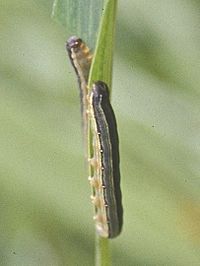
Pheromone-binding proteins in the Asian gypsy moth females, Lymantria dispar, recognizing the sex pheromone and plant volatiles.
Sign Up to like & getrecommendations! Published in 2018 at "Archives of insect biochemistry and physiology"
DOI: 10.1002/arch.21477
Abstract: Lepidopterans are known to have different pheromone-binding proteins with differential expression patterns that facilitate specific signal transduction of semiochemicals. Two PBPs of the Asian gypsy moth, Lymantria dispar, were reported to express in both females… read more here.
Keywords: binding proteins; pheromone binding; sex pheromone; asian gypsy ... See more keywords

Ostrinia furnacalis PBP2 solution NMR structure: Insight into ligand binding and release mechanisms
Sign Up to like & getrecommendations! Published in 2022 at "Protein Science"
DOI: 10.1002/pro.4438
Abstract: Ostrinia furnacalis is an invasive lepidopteran agricultural pest that relies on olfaction for mating and reproduction. Male moths have an extremely sensitive olfactory system that can detect the sex pheromones emitted by females over a… read more here.
Keywords: ostrinia furnacalis; structure; release; furnacalis pbp2 ... See more keywords

Reverse chemical ecology guides the screening for Grapholita molesta pheromone synergists.
Sign Up to like & getrecommendations! Published in 2021 at "Pest management science"
DOI: 10.1002/ps.6674
Abstract: BACKGROUND Pheromone-based management is a leading non-pesticidal strategy among integrated pest management options. Improving the potency of pheromone products by adding synergists would be a practical way to popularize pheromone-based management as well as to… read more here.
Keywords: codlemone; molesta; chemical ecology; pheromone ... See more keywords

Structural insights into the discrepant synergistic activity of Codlemone and (Z)-8-dodecenol towards Grapholita molesta pheromones.
Sign Up to like & getrecommendations! Published in 2022 at "Pest management science"
DOI: 10.1002/ps.6813
Abstract: BACKGROUND Insect pheromone synergists have been widely used to produce potent pheromone products for environment-friendly pest control. Codlemone (Cod) and (Z)-8-dodecenol (Dod) are two major Grapholita molesta pheromone synergists, with Cod having greater synergism and… read more here.
Keywords: interaction; grapholita molesta; c10 c11; gmolpbp2 ... See more keywords

Identification of a unique three-component sex pheromone produced by the tea black tussock moth, Dasychira baibarana (Lepidoptera: Erebidae: Lymantriinae).
Sign Up to like & getrecommendations! Published in 2022 at "Pest management science"
DOI: 10.1002/ps.6892
Abstract: BACKGROUND The tea black tussock moth Dasychira baibarana Matsumura is a devastating pest in tea plantations that causes substantial economic losses. Presently, there is no effective method to control this pest other than pesticide application.… read more here.
Keywords: tea black; baibarana; dasychira baibarana; pheromone ... See more keywords

Nonanal, a new fall armyworm sex pheromone component, significantly increases the efficacy of pheromone lures.
Sign Up to like & getrecommendations! Published in 2023 at "Pest management science"
DOI: 10.1002/ps.7460
Abstract: BACKGROUND The fall armyworm (FAW), Spodoptera frugiperda (J.E. Smith), is a global pest that feeds on more than 350 plant species and severely limits production of cultivated grasses, vegetable crops and cotton. An efficient way… read more here.
Keywords: component; fall armyworm; pheromone lures; pheromone ... See more keywords

Knockout of tyramine receptor 1 results in a decrease of oviposition, mating, and sex pheromone biosynthesis in female Plutella xylostella.
Sign Up to like & getrecommendations! Published in 2023 at "Pest management science"
DOI: 10.1002/ps.7571
Abstract: BACKGROUND Mating and oviposition are essential and closely coordinated events in the reproduction of moths. Although tyramine, a biogenic amine, can affect insect reproduction by binding its receptors, the specific regulatory mechanism has not yet… read more here.
Keywords: pheromone biosynthesis; pheromone; knockout; sex pheromone ... See more keywords

Identification of a hyperactive pheromone analog in field tests of pheromone mimics for two click beetle species in the genus Cardiophorus (Coleoptera: Elateridae)
Sign Up to like & getrecommendations! Published in 2020 at "Chemoecology"
DOI: 10.1007/s00049-020-00319-z
Abstract: Females of two click beetle species, Cardiophorus tenebrosus and C. edwardsi (Coleoptera: Elateridae), produce methyl (3R,6E)-2,3-dihydrofarnesoate as their sex pheromone. We had serendipitously discovered that males of both species were also strongly attracted to (R)-fuscumol… read more here.
Keywords: coleoptera; two click; field; beetle species ... See more keywords

Increased pheromone signaling by small male sea lamprey has distinct effects on female mate search and courtship
Sign Up to like & getrecommendations! Published in 2017 at "Behavioral Ecology and Sociobiology"
DOI: 10.1007/s00265-017-2384-3
Abstract: Male body size affects access to mates in many animals. Attributes of sexual signals often correlate with body size due to physiological constraints on signal production. Larger males generally produce larger signals, but costs of… read more here.
Keywords: body mass; mass; size; courtship ... See more keywords

Molecular identification of differential expression genes associated with sex pheromone biosynthesis in Spodoptera exigua
Sign Up to like & getrecommendations! Published in 2017 at "Molecular Genetics and Genomics"
DOI: 10.1007/s00438-017-1307-3
Abstract: Species-specific sex pheromone is biosynthesized and released in most female moths as a chemical cue in mating communication. However, information on genes involved in this pathway is limited. The beet armyworm, Spodoptera exigua, is a… read more here.
Keywords: exigua; sex pheromone; sex; pheromone ... See more keywords

The expression patterns of SNMP1 and SNMP2 underline distinct functions of two CD36-related proteins in the olfactory system of the tobacco budworm Heliothis virescens
Sign Up to like & getrecommendations! Published in 2019 at "Cell and Tissue Research"
DOI: 10.1007/s00441-019-03066-y
Abstract: In insects, male and female pheromone signals are detected by olfactory sensory neurons (OSNs) expressing the “sensory neuron membrane protein type 1”. SNMP1 is supposed to function as a co-receptor involved in the transfer of… read more here.
Keywords: sensilla; pheromone; trichoid sensilla; heliothis virescens ... See more keywords